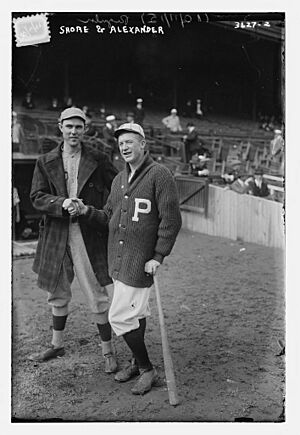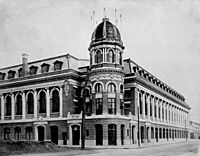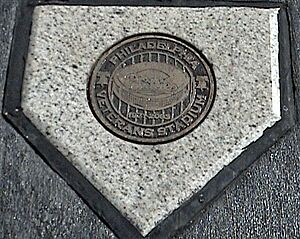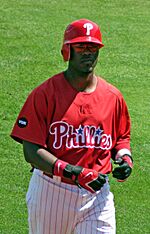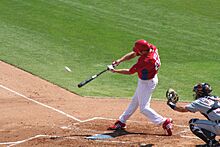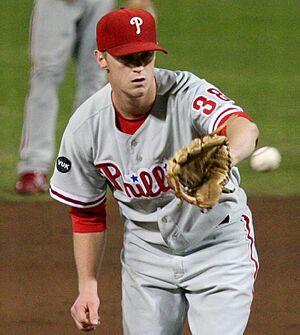History of the Philadelphia Phillies facts for kids
The history of the Philadelphia Phillies, a team in Major League Baseball's National League, began on November 1, 1882. That's when a group called the Philadelphia Ball Club Limited was formed. In 1883, this group won the right to have a baseball team in Philadelphia. The city was chosen to replace the Worcester Worcesters from Massachusetts, who had stopped playing after the 1882 season.
The Phillies first played in the postseason in 1915, but they lost to the Boston Red Sox in the World Series. The team also holds the record for the second-longest streak of losing seasons in American professional sports: 16 straight years from 1933 to 1948. This record was broken in 2009 by the Pittsburgh Pirates. After winning another National League championship in 1950, the Phillies didn't return to the playoffs until 1976. That year started a long period of success for the team. From 1975 to 1983, they won five East Division championships. They also won the first half of the strike-shortened 1981 season. The team made the playoffs five years in a row from 2007 to 2011.
The Phillies currently play in the National League East division. Since 2004, their home field has been Citizens Bank Park in South Philadelphia. The team has won two World Series championships (in 1980 against the Kansas City Royals and in 2008 against the Tampa Bay Rays). They have also won eight National League championships.
In their 127-season history, the Phillies have had 51 different managers and 10 general managers (GMs). Dallas Green and Charlie Manuel are the only Phillies managers to win a World Series. Green won in 1980, and Manuel won in 2008. Manuel is also the only Phillies manager to win two league championships. On the last day of the 2011 season, he passed Gene Mauch's record for most wins as a Phillies manager. He did it in two fewer seasons than Mauch. The longest-serving general manager was Paul Owens, who worked for the team for 11 years as GM from 1972 to 1983. Owens also managed the team in 1972 and from 1983 to 1984. He was later honored on the Philadelphia Baseball Wall of Fame.
Contents
- How the Phillies Began
- Early 1900s Challenges
- The 1930s and 1940s
- The 1950s: The Whiz Kids
- The "Phold" of 1964
- The 1970s
- 1980: First World Series Championship
- 1981–1992: Ups and Downs
- 1993: From Worst to First
- 1994–2005: Rebuilding Time
- 2006: Changes and New Stars
- 2007–2011: Dominating the NL East
- 2012–2017: Struggles and Rebuilding
- 2018–Present: Slowly Getting Better
- Images for kids
How the Phillies Began
The Philadelphia Phillies team was started on November 1, 1882. It was called the Philadelphia Ball Club Limited and had $15,000 in funding. A group led by sporting goods maker Al Reach and lawyer John Rogers created it. Their goal was to play baseball in Philadelphia.
In 1883, Reach and Rogers got a new team spot in the National League for Philadelphia. This league is now known for its "Classic Eight" original teams. They took the place of the Worcester Worcesters team, which had stopped playing in 1882. The new Philadelphia team was first nicknamed the "Quakers." They had a very low winning percentage of .173 that first year, which is still the worst in the team's history.
Many people, including the Phillies themselves, used to say that Reach and Rogers bought the Worcester team and moved it. However, old records show there was no direct link between the two teams. For example, no players from the 1882 Worcesters joined the 1883 Phillies.
The Phillies played their very first game on April 2, 1883. They beat the amateur Manayunk Ashlands 11–0 at Recreation Park. The Philadelphia Inquirer newspaper called the team the "Phillies" in its report on April 3, 1883. This was a common practice then; teams were often named after their cities, like "Bostons" or "New Yorks." But "Philadelphias" was too long for headlines, so the Inquirer shortened it to "Phillies." The press often used "Phillies" and "Quakers" names for the team until the 1890s. "Phillies" is one of the oldest team nicknames still used by a professional sports team in the same city.
In 1884, Harry Wright became the manager. He had managed baseball's first professional team, the Cincinnati Red Stockings. Wright brought respect to the team right away. In 1887, the Phillies started playing at the Philadelphia Ball Park, which later became known as Baker Bowl. The team played well in the 1890s. Star players from that time included Billy Hamilton, Sam Thompson, and Ed Delahanty. In 1896, Delahanty hit 4 home runs in one game, which was a major-league record.
Early 1900s Challenges
The Phillies had problems with their best players, Ed Delahanty and Nap Lajoie, in the late 1890s. They didn't want to pay them enough. In 1901, the American League started, offering higher pay to players. Many Phillies players left to join the American League, including some who went to their rival team, the Athletics.
The Phillies didn't try to keep their players, and their former teammates did very well in the new league. The remaining Phillies team played very badly, finishing 46 games out of first place in 1902. This was the first of three years they finished near the bottom of the league. To make things worse, a serious accident happened at the Philadelphia Ball Park in 1903, which led to many lawsuits. The owner, Rogers, had to sell the Phillies to avoid financial ruin.
The Phillies won their first league championship in 1915. This was thanks to the great pitching of Grover Cleveland Alexander and the strong hitting of Gavvy Cravath. Cravath set a major-league record with 24 home runs that season. However, by 1917, Alexander was traded away because the owner, William Baker, refused to pay him more. Baker was known for running the Phillies very cheaply. For example, for many years, the team only had one scout to find new players.
The trade of Alexander had an immediate effect. In 1918, just three years after winning the championship, the Phillies finished poorly. This started one of the longest periods of bad play in baseball history. From 1918 to 1948, the Phillies had only one winning season (in 1932). They rarely finished higher than sixth place and were never serious contenders. During this time, they finished last 17 times and second to last seven times. This gave the team a reputation for losing that lasted for many years.
The team's main stars in the 1920s and 1930s were outfielders Cy Williams, Lefty O'Doul, and Chuck Klein. Klein won the Triple Crown in 1933, meaning he led the league in batting average, home runs, and runs batted in. Unfortunately, the Phillies' home field, Baker Bowl, was also easy for opposing teams to hit in. In 1930, the team gave up 1199 runs, which is still a major-league record.
The 1930s and 1940s
Owner William Baker died in 1930, and Charlie Ruch took over. After only two years, Ruch retired due to health reasons. With the support of Baker's widow, team business manager Gerald Nugent became team president. Nugent and his wife, Mae Mallon Nugent, eventually gained control of the team.
Unlike Baker, Nugent really wanted to build a winning team. He started creating a system to develop young players, which the team had never really had before. He was also good at finding unknown talented players. However, he didn't have enough money to make the Phillies a top team. He often had to trade away good players just to keep the team going.
One big problem was Baker Bowl. It used to be a great park, but it wasn't kept up well after the 1910s. For example, until 1925, the Phillies used sheep to cut the grass! Fans sometimes got rust showered on them when a home run hit the stadium's metal beams. In 1926, part of the stadium collapsed, forcing the Phillies to move to the A's Shibe Park in 1927.
For several years, the Phillies tried to move to Shibe Park permanently. But the park's owners wouldn't let them out of their lease at Baker Bowl. Finally, after Nugent threatened to sue, they agreed to let the Phillies move to Shibe Park.
The team's lowest point came in 1941, when the Phillies finished with a terrible 43–111 record, losing the most games in franchise history. A year later, they even needed money from the league just to go to spring training. Nugent realized he couldn't afford to run the team in 1943 and put it up for sale. A minor-league executive named Bill Veeck wanted to buy it and planned to sign Negro league stars. However, when Baseball Commissioner Kenesaw Mountain Landis, who supported segregation, found out, he pressured the league to take over the Phillies instead.
A week later, the league sold the Phillies to a rich lumber businessman named William B. Cox. Cox was committed to building a winning team and had the money to do it. He immediately put more money into player salaries and developing young players. His efforts quickly made a difference. By July, the team had already won almost as many games as they had the entire previous season. They also got out of last place for the first time in five years. Fans appreciated Cox's efforts, and attendance went up for the first time in nearly 30 years.
Cox then sold most of his ownership to DuPont heir Robert R.M. Carpenter. Carpenter then gave control to his son, Bob Jr..
Bob Carpenter Jr.'s first idea was to change the team's name to the "Blue Jays" to get rid of their losing image. He said he admired the "scrappy qualities" of the blue jay. However, the name "Phillies" still appeared on the team's jerseys, with a blue jay on the sleeves. Students at Johns Hopkins University, whose teams are also called the Blue Jays, protested the change because of the Phillies' losing history. The "Blue Jays" nickname was officially dropped on January 10, 1950.
The 1950s: The Whiz Kids
Like Cox, Bob Carpenter Jr. was willing to spend money to build a winning team. He started signing young players and invested even more in the team's farm system (where young players develop). The Phillies quickly built a strong group of young players known as the "Whiz Kids." This group included future Hall of Famers Richie Ashburn and Robin Roberts.
Things started to improve for the Phillies in 1949. They moved up to third place with an 81–73 record. This was the Phillies' first time finishing in the top half of the league in 31 years. It was also a tribute to Bob Carpenter Sr., who had died in June and left Bob Jr. in full control of the team.
The Phillies led the National League for most of the 1950 season. However, a late-season slump, partly because pitcher Curt Simmons had to leave for National Guard service, caused them to lose eight of ten games. On the last day of the season, the Phillies held onto a one-game lead. Dick Sisler hit a dramatic three-run home run in the tenth inning against the Dodgers, which won the team their first championship in 35 years. In the World Series, the Phillies were tired and had bad luck. They were swept by the New York Yankees in four games. Still, this appearance made the Phillies the city's favorite team. In 1954, the Athletics team moved to Kansas City, and the Phillies bought Shibe Park (renamed Connie Mack Stadium in 1953).
Many people thought the Whiz Kids, with their young, talented players, would be a top team for years. However, the team finished with a 73–81 record in 1951. Except for tying for second place in 1964, they didn't finish higher than third place until 1975. Part of their lack of success was blamed on Carpenter's unwillingness to sign black players after winning a championship with an all-white team. The Phillies were the last National League team to sign a black player, 10 years after Jackie Robinson played for the Brooklyn Dodgers. Their poor performance was highlighted by a record that still stands: in 1961, the Phillies lost 23 games in a row, the worst losing streak in the major leagues since 1900.
The "Phold" of 1964
Between 1953 and 1962, the Phillies finished at least 18 games out of first place every year. They hit a low point in 1961 when they lost 107 games. In 1963, the Phillies started to play better. In 1964, they seemed sure to make it to the World Series. They had excellent players like rookie third baseman Dick Allen (who won Rookie of the Year), pitchers Jim Bunning and Chris Short, and star right fielder Johnny Callison. On Father's Day, Bunning pitched a perfect game against the New York Mets, the first in Phillies history.
TV Guide even printed a World Series preview with a picture of Connie Mack Stadium. However, with a 6 1/2-game lead over the Cincinnati Reds and only 12 games left, Philadelphia had a terrible 10-game losing streak. The "Phold of '64" is often called one of the worst collapses in sports history.
The 1970s
By the late 1950s, Carpenter decided the Phillies needed a new home. He didn't want to own Connie Mack Stadium and felt he couldn't make money there. The stadium didn't have enough parking and couldn't be expanded. The Phillies stayed at the old stadium until 1970. In their last game there, the Phillies avoided last place by beating the Expos 2–1.
The Phillies opened the new Veterans Stadium in 1971, hoping for a fresh start. In their first season there, pitcher Rick Wise threw a no-hitter. That same season, Harry Kalas joined the Phillies broadcasting team. In 1972, the Phillies were the worst team in baseball, but newly acquired Steve Carlton won almost half their games (27 of 59 team wins). That same year, Bob Carpenter retired and passed team ownership to his son Ruly.
By 1974, the Phillies began their journey to win a championship, which they would achieve six years later. That year, second baseman Dave Cash created the phrase "Yes We Can" for the team. The Phillies had some success in the mid-1970s. With players like Carlton, third baseman Mike Schmidt, shortstop Larry Bowa, and outfielder Greg Luzinski, the Phillies won three straight division titles (1976–78). However, they lost in the NLCS each time. In 1979, the Phillies acquired Pete Rose, who helped them win the championship.
1980: First World Series Championship
The Phillies won the NL East in 1980. To win the league championship, they had to beat the Houston Astros. In a memorable NLCS, four of the five games went into extra innings. The Phillies fell behind 2–1 but fought back to win. Center fielder Garry Maddox hit a game-winning single in the tenth inning, and the city celebrated its first league championship in 30 years.
Facing the Kansas City Royals in the 1980 World Series, the Phillies won their first world championship in six games. This was thanks to the timely hitting of Mike Schmidt and Pete Rose. Schmidt, who was the NL MVP for the 1980 season, also won the World Series MVP award. He hit .381 and had game-winning hits in Game 2 and the final Game 6. The Phillies became the last of the 16 teams that made up the major leagues from 1903 to 1960 to win a World Series.
1981–1992: Ups and Downs
The team made the playoffs in the strike-shortened 1981 season, but lost to Montreal. After the 1981 season, Ruly Carpenter sold the team to a group of investors led by team executives Bill Giles and David Montgomery.
In 1983, the "Wheeze Kids" (an older version of the "Whiz Kids") won their fourth league championship, but lost the 1983 World Series to Baltimore in five games. The 1983 season was the Phillies' 100th year. On September 28, they beat the Chicago Cubs, 13–6. This win gave the Phillies the National League East Division championship. It was also the 7,000th win in team history.
The Phillies struggled for most of the rest of the 1980s and early 1990s. They were not serious contenders for a championship for the rest of the decade. During this time, the 1984 team was the only one that even managed to win as many games as they lost. The Phillies often had trouble attracting more than 25,000 people to Veterans Stadium, which was the biggest in the National League at the time.
One reason for the Phillies' decline was trading Iván DeJesús from the Cubs for Larry Bowa and a young player named Ryne Sandberg. This trade is now seen as one of the most unfair trades in baseball history. Sandberg went on to have a Hall of Fame career.
On August 15, 1990, Terry Mulholland pitched a no-hitter. The 1992 season ended with the Phillies in last place. However, their luck was about to change.
1993: From Worst to First
The 1993 Phillies team was led by stars like Darren Daulton, John Kruk, Lenny Dykstra, and Curt Schilling. The team played very well, finishing with a 97–65 record and winning the East division title. They had a great April, winning 17 of 22 games. Each game seemed to have a new hero, and the season was full of exciting games. The 1993 Phillies team was also known for how close the players and coaches were.
The Phillies' main hitters were outfielders Lenny Dykstra and Jim Eisenreich, first baseman John Kruk, and shortstop Kevin Stocker. All of them hit over .300 for the season. Their pitching staff was led by 16-game winners Curt Schilling and Tommy Greene. Every starting pitcher won at least 10 games. The bullpen (relief pitchers) was led by veteran Larry Andersen and closer Mitch "Wild Thing" Williams, who had 43 saves.
The Phillies beat the Atlanta Braves (who had won the National League championship twice in a row) in the 1993 National League Championship Series, four games to two. This earned them their fifth league championship in team history. They then faced the defending world champion Toronto Blue Jays in the 1993 World Series. Philadelphia lost the Series in six games. Toronto's Joe Carter hit a game-winning three-run home run off Mitch Williams in Game 6, giving the Blue Jays their second straight championship. After that loss, Williams received threats from some angry Phillies fans. He later left for the Astros.
1994–2005: Rebuilding Time
After the 1994 players' strike, many Phillies fans were upset. For the next decade, the team didn't have much success on the field or with attendance. The Atlanta Braves also moved into the National League East in 1994 and won the division every year until 2006, often by a lot. During this time, the team developed many players who would later become stars and win the 2008 World Series. These players included Chase Utley, Ryan Howard, Jimmy Rollins, Brett Myers, and Cole Hamels.
Former Phillie Larry Bowa was hired as manager for the 2001 season. He led the Phillies to an 86–76 record, their first winning season since the 1993 World Series year. They were in first place for most of the first half of the season and battled the Braves for first place in the second half. They finished just two games out of first place. Bowa was named National League Manager of the Year. The Phillies continued to play well for the next few years under Bowa.
In 2003, their last season at Veterans Stadium, the Phillies were expected to compete for the World Series. They had added players like Jim Thome, Kevin Millwood, and David Bell. However, some key players struggled, and the bullpen was inconsistent. The team finished 86–76 and in third place.
The opening of the new Citizens Bank Park in 2004 brought new hope. The team was expected to win the NL East. However, they finished far behind in second place, and Bowa was fired with two games left in the season.
Charlie Manuel took over as manager for 2005. He kept the Phillies in contention throughout the season. They were only eliminated from the wild card race on the second-to-last day. However, this wasn't enough to save general manager Ed Wade's job; he was fired after eight seasons. Soon after, the Phillies hired Pat Gillick, who had been the general manager for the 1992 and 1993 Toronto Blue Jays championship teams. Despite another late-season disappointment, 2005 saw the Phillies team change. They moved away from older players like Thome and Abreu to younger, home-grown stars like Rollins, Utley, Brett Myers, and Ryan Howard.
2006: Changes and New Stars
General Manager Pat Gillick made many trades in 2006 to change the team and get more money to "retool" it. On July 26, 2006, the Phillies traded catcher Sal Fasano to the New York Yankees. Two days later, they traded third baseman David Bell to the Milwaukee Brewers. Gillick also made a big trade that sent outfielder Bobby Abreu and pitcher Cory Lidle to the Yankees.
The team played well after these changes. All-Star second baseman Chase Utley and first baseman Ryan Howard became key hitters and team leaders, along with shortstop Jimmy Rollins. On August 18, Gillick acquired veteran pitcher Jamie Moyer, who was from a Philadelphia suburb. By September 24, the Phillies were tied with the Los Angeles Dodgers for the wild-card spot. On September 30, the Phillies were eliminated from playoff contention.
Ryan Howard was named the National League's Most Valuable Player, just beating out the St. Louis Cardinals' Albert Pujols.
2007–2011: Dominating the NL East
2007: A Big Comeback
The Phillies started the 2007 season with a loss on April 2. After 15 games, they had a poor 4–11 record, but then won five games in a row to get back into the race. After 40 games, they reached a .500 record (20 wins and 20 losses).
Three Phillies players were chosen for the 2007 Major League Baseball All-Star Game in San Francisco. Chase Utley was the starting second baseman, and center fielder Aaron Rowand was a backup. Pitcher Cole Hamels also made his first All-Star appearance.
On July 15, 2007, the Phillies lost their 10,000th game. They became the first North American professional sports team to lose 10,000 games.
On September 21, Jimmy Rollins became the first player in major league history to get 200 hits, 15 triples, 25 home runs, and 25 stolen bases in the same season.
On September 12, the Phillies were seven games behind the New York Mets in the National League East. It looked like their hopes were gone. However, the Mets had a huge collapse, similar to the "Phold of 1964." The Mets went 4–11 over the next 15 games, while the Phillies played very well, winning 12 of 15 games. The Phillies had beaten the Mets eight times in a row and finally passed them by one game on September 28. The Phillies won the division on the last day of the season, clinching it for the first time in 14 years.
After their amazing comeback, they were swept in three games by the Colorado Rockies in the playoffs. This was the first time since 1976 that the Phillies were swept in a postseason series.
On November 20, 2007, Jimmy Rollins was named National League MVP. Along with Ryan Howard's MVP win in 2006, they became the first baseball team with back-to-back MVP winners since the San Francisco Giants in 2000 and 2001.
2008: Second World Series Championship
The Phillies were seen as favorites to win their division again in 2008. They had their first winning April since 2003. Chase Utley led the team's hitting with a .360 batting average and 11 home runs. Pat Burrell also played very well. Even with Shane Victorino and Jimmy Rollins out with injuries, the Phillies had a 15–13 record. Pitcher Cole Hamels led the team in wins, ERA, and innings pitched. Relievers J. C. Romero and new closer Brad Lidge didn't give up any runs in April.
Jayson Werth became a valuable player in May. He showed flashes of his talent, including a game with three home runs. Ryan Howard started hitting better, and hometown pitcher Jamie Moyer became the sixth pitcher in Major League Baseball history to beat all 30 teams in the league on May 26.
June was a mixed month for the Phillies. They had a strong start but then struggled, losing six games in a row. Pitcher Brett Myers struggled and was sent to the minor leagues to work on his pitching.
In July, Chase Utley and Brad Lidge were chosen for the 2008 Major League Baseball All-Star Game. To make their starting pitching stronger for the championship race, the Phillies traded for pitcher Joe Blanton on July 17.
On September 27, the Phillies won the National League East for the second year in a row. They were again helped by a late-season slump from the New York Mets. The Phillies then won their playoff series against the Milwaukee Brewers and beat the Los Angeles Dodgers to become National League champions. As the National League champions, the Phillies went to the 2008 World Series to play the Tampa Bay Rays. The Phillies won the World Series 4–1, with strong pitching. Hamels was named the MVP for both the NLCS and the World Series.
2009: Back to the World Series
The Phillies had another winning April in 2009. However, the month was sad because of the death of legendary broadcaster Harry Kalas. In May, the Phillies visited President Barack Obama to celebrate their World Series win. Pitcher Jamie Moyer earned his 250th career win. First baseman Ryan Howard and outfielder Raúl Ibañez became the first Phillies teammates to hit 10 home runs in the same month. The Phillies played very well in late May and early June.
In July, five Phillies players—Howard, Ibáñez, second baseman Chase Utley, and outfielders Shane Victorino and Jayson Werth—were chosen for the All-Star team. July was the team's best month of the season. The Phillies traded for pitcher Cliff Lee at the end of the month to strengthen their pitching. They also signed free-agent pitcher Pedro Martínez. In August, Eric Bruntlett made the first game-ending unassisted triple play in National League history. The following month, the team won its third straight division championship on September 30.
Philadelphia beat the Colorado Rockies in the National League Division Series (NLDS) and the Los Angeles Dodgers in the National League Championship Series (NLCS) for the second year in a row. Howard was named the MVP of the NLCS. The Phillies lost to the New York Yankees in the 2009 World Series, four games to two.
2010: Fourth Straight Division Title
After the 2010 season, Jayson Werth left the Phillies for a bigger contract with the Washington Nationals.
One of the best moments of the season happened on May 29, when Roy Halladay pitched a perfect game. This was the second perfect game in Phillies history.
The Phillies finished with a 97–65 record, the best in major league baseball. In the NLDS, they swept the Cincinnati Reds. In Game 1, Halladay threw a no-hitter in his first career postseason start. This was only the second postseason no-hitter in Major League Baseball history. The Phillies lost the 2010 National League Championship Series, four games to two, to the San Francisco Giants.
Halladay was named the National League's Cy Young Award winner for best pitcher.
2011: Fifth Straight Division Title
In 2011, the Phillies had a starting pitching group that ESPN called the "best rotation in major league history." This group included Roy Halladay, Roy Oswalt, Cliff Lee, Cole Hamels, and Joe Blanton. Blanton was injured and replaced by Vance Worley, a young pitcher who had an 11–3 record in 2011. The Phillies won 14 games in a row when Worley started.
On August 16, a bronze statue of Hall of Fame announcer Harry Kalas was unveiled at Citizens Bank Park. The statue was paid for by donations from fans.
The Phillies finished with a 102–60 record, the best in franchise history and the best regular-season record in MLB in 2011. The previous record was 101–61, set in both 1976 and 1977.
The Phillies eliminated the Atlanta Braves from wild card contention on the last day of the regular season. The St. Louis Cardinals caught and passed the Braves and faced the Phillies in the 2011 National League Division Series. The Phillies lost the deciding Game 5 at Citizens Bank Park. The Cardinals went on to win the World Series.
2012–2017: Struggles and Rebuilding
2012: End of a Winning Streak
In the 2011–2012 off-season, the Phillies signed closer Jonathan Papelbon and other players.
During the season, the Phillies played poorly in the early and middle months and fell into last place. The Phillies traded away Shane Victorino, Joe Blanton, and Hunter Pence in August. Team management didn't think they could reach the postseason.
In August, the Phillies started playing much better. They finished with an 81–81 record, after being 14 games below .500 in the middle of the season. The Phillies finished in third place in their division and missed the playoffs.
2013: Continued Struggles
The Phillies didn't make many big changes in the off-season, hoping to play better. They traded for Ben Revere from the Twins. They struggled all season and never had a winning record in any month. On August 16, 2013, the Phillies fired Charlie Manuel after a 53–67 record. He was replaced by third base coach Ryne Sandberg for the rest of the season. The Phillies ended the season 73–89 and missed the playoffs for the second year in a row. Many fans blamed general manager Ruben Amaro Jr. for not getting enough new players.
2014: No Improvement
After the 2013 season, Roy Halladay retired from baseball, and many changes were made to the Phillies team. Despite the changes, the team still struggled to play consistently, especially in hitting. The Phillies didn't have a winning record in any month until August. They ended the season 73–89, the same record as the previous year.
2015: Last Place
Expectations were low for the Phillies in 2015. Many thought they would be the worst team in MLB because of their older star players. Many veteran players were traded away: Jimmy Rollins and Chase Utley went to the Los Angeles Dodgers, and Cole Hamels was traded to the Texas Rangers. Cliff Lee was injured and became a free agent. Ruben Amaro Jr. was fired near the end of the season, and Ryne Sandberg resigned during the middle of the season. Pete Mackanin took over as the interim manager. They ended the season with a 63–99 record, the worst in MLB.
2016: Signs of Hope
The Phillies had a surprising start in 2016, with a 22–16 record by mid-May. This was due to strong pitching from Aaron Nola and Vince Velasquez. However, this didn't last. They eventually struggled and finished 71–91, missing the playoffs for the fifth year in a row. Ryan Howard was not re-signed, and Carlos Ruiz was traded. This meant the last of the original 2008 Phillies championship players were gone from the roster.
2017: Stepping Back
The Phillies took a step back in 2017. Their pitching and hitting were inconsistent all season. One bright spot was Rhys Hoskins, who was called up from the minor leagues and hit 18 home runs in just 34 games. The Phillies finished 66–96 and missed the playoffs for the sixth year in a row. At the end of the season, Pete Mackanin stepped down as head coach and took an office role with the team.
2018–Present: Slowly Getting Better
2018: A Promising Future
The Phillies named Gabe Kapler as their new head coach on October 30, 2017. Kapler was a retired baseball player. Kapler and the Phillies were a surprise team in their division, battling with the Washington Nationals and the Atlanta Braves. However, the Phillies struggled at the end of the season, going 8–20 in September. They finished 80–82 and missed the playoffs for the seventh year in a row.
2019: Big Signings
Because the Phillies had a lot of money to spend, many reporters thought they would sign many free agents after a promising 2018 season. The Phillies signed Andrew McCutchen, traded for Jean Segura and J. T. Realmuto, and signed Bryce Harper to a huge 13-year, $330 million contract. In the first Phillies at-bat of the season, Andrew McCutchen hit a home run. The Phillies swept the Braves in the first series and started 4–0. While the team started very well, they struggled in the middle of the season. Injuries to many outfielders and bullpen players, and overall poor play as the season ended, led to the team finishing with an 81–81 record. They missed the playoffs again. On October 10, 2019, Gabe Kapler was fired as manager.
2020: The Joe Girardi Era Begins
The Phillies started the off-season by hiring Joe Girardi as their new manager. They improved their starting pitching by signing Zack Wheeler. They also signed shortstop Didi Gregorius. The year was affected by the COVID-19 pandemic, shortening the season. The team struggled with its bullpen, which was one of the worst in baseball history. Highlights included a period where Bryce Harper was considered for MVP. The team finished 2–6 to close out the season, missing the playoffs.
2021: End of a Losing Decade
In 2021, the Phillies had their first winning season since 2011, finishing second in their division with an 82–80 record. Bryce Harper was named the National League MVP. Zack Wheeler led the National League in strikeouts and finished second in Cy Young Award voting for best pitcher.
2022: National League Champions
After a regular season with 87 wins and 75 losses, the Phillies entered the postseason as a wild card team. They finished third in their division. They went on to win the National League championship, beating St. Louis, Atlanta, and San Diego in the playoffs. This success was largely due to excellent pitching from Zack Wheeler and strong hitting from Rhys Hoskins and Bryce Harper. In the World Series, the Phillies took a 2–1 lead after three games. However, they were defeated by the Houston Astros in the next three games, ending their underdog run.
Images for kids



